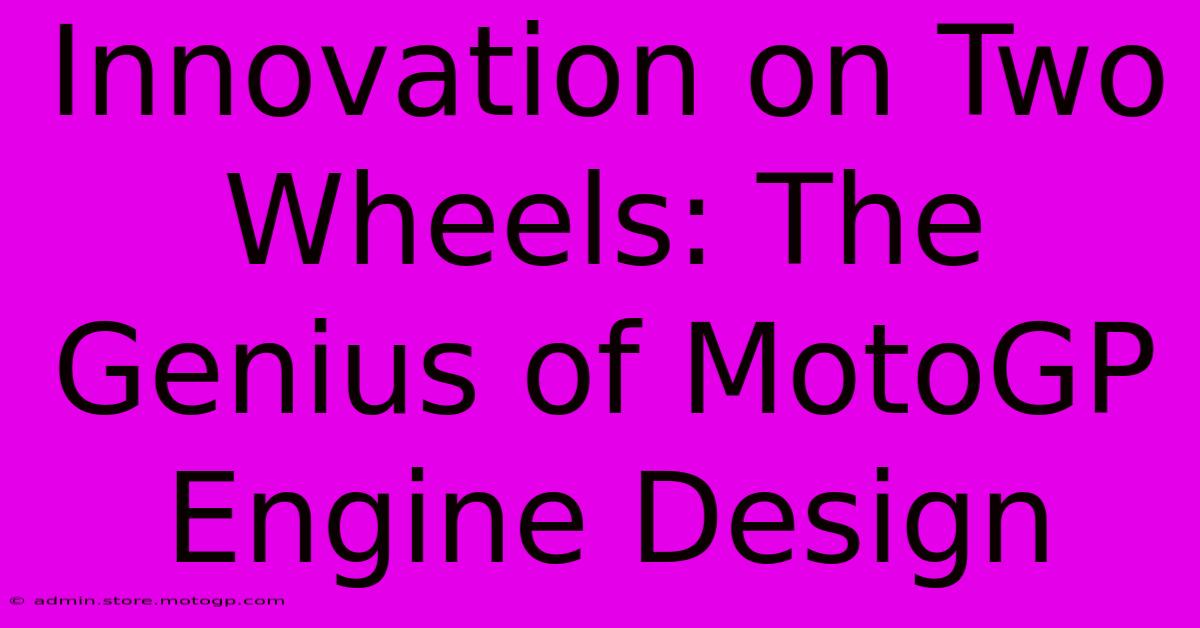Innovation On Two Wheels: The Genius Of MotoGP Engine Design

Table of Contents
Innovation on Two Wheels: The Genius of MotoGP Engine Design
MotoGP. The name conjures images of screaming engines, breathtaking speeds, and the pinnacle of motorcycle racing technology. But beyond the thrilling spectacle lies a world of relentless innovation, particularly in engine design. This isn't just about going fast; it's about pushing the boundaries of what's possible, constantly refining performance and efficiency in a fiercely competitive environment.
The Heart of the Beast: MotoGP Engine Specs
At the heart of every MotoGP machine beats a powerful, finely-tuned engine. Currently, the regulations mandate four-stroke, 1000cc prototypes, though the specifics vary dramatically between manufacturers. These aren't your average production motorcycle engines; they are meticulously engineered masterpieces, boasting incredible power-to-weight ratios and advanced technologies.
Key Engine Features:
- High RPM Capability: MotoGP engines rev to incredibly high RPMs, often exceeding 16,000 RPM, generating phenomenal power output. This requires incredibly robust internal components and precise engineering.
- Lightweight Materials: The use of lightweight materials like titanium, magnesium, and carbon fiber is paramount. Every gram saved contributes to improved handling and acceleration.
- Sophisticated Electronics: Modern MotoGP engines rely heavily on sophisticated electronics. Engine control units (ECUs) manage fuel injection, ignition timing, and other critical parameters in real-time, optimizing performance based on track conditions and rider input.
- Aerodynamics: While not strictly part of the engine itself, aerodynamics play a crucial role in overall performance. The engine's position and fairing design contribute significantly to the bike's downforce and stability at high speeds.
- Exhaust System Design: The exhaust system isn't just a pipe; it's an integral part of engine performance. Careful design optimizes gas flow, reducing back pressure and maximizing power output. The sound alone is a testament to the engineering involved.
Constant Evolution: The Driving Force of Innovation
The MotoGP engine landscape is in constant flux. Manufacturers are constantly striving for a competitive edge, leading to a relentless cycle of innovation. Each season brings new breakthroughs in:
1. Engine Configuration:
Different manufacturers employ varying engine configurations, such as inline fours, V4s, and even V5s. Each configuration offers unique advantages in terms of power delivery, handling characteristics, and packaging. The quest for optimal power and handling dictates the choices made here.
2. Materials Science:
The pursuit of lighter and stronger materials is a never-ending story. Advances in materials science are crucial in improving engine performance and durability. Manufacturers constantly explore new alloys, composites, and manufacturing techniques to achieve these goals.
3. Electronics and Software:
Sophisticated engine management systems are constantly refined. Advanced algorithms optimize fuel injection, ignition, and other parameters to extract maximum performance under various conditions. This requires cutting-edge software development and sophisticated sensors.
4. Aerodynamics:
The interaction between the engine and the bike's aerodynamics is crucial. Innovations in fairing design and engine placement directly impact downforce, drag, and overall speed. Wind tunnel testing plays a vital role in this area.
The Ripple Effect: Technology Transfer to the Street
The intense competition and technological advancements in MotoGP don't stay confined to the racetrack. Many innovations developed for MotoGP engines eventually find their way into production motorcycles, albeit in a less extreme form. This technology transfer benefits everyday riders, making bikes safer, faster, and more efficient.
Conclusion: A Continuous Pursuit of Excellence
MotoGP engine design isn't just about winning races; it's a testament to human ingenuity and a relentless pursuit of excellence. The innovations developed in this highly competitive environment push the boundaries of what's possible, leading to continuous advancements in motorcycle technology that ultimately benefit riders worldwide. The roar of a MotoGP engine is the sound of innovation, a constant reminder of the dedication and skill that goes into creating these incredible machines.

Thank you for visiting our website wich cover about Innovation On Two Wheels: The Genius Of MotoGP Engine Design. We hope the information provided has been useful to you. Feel free to contact us if you have any questions or need further assistance. See you next time and dont miss to bookmark.
Featured Posts
-
Formula 1 Parking Arrive In Style Park With Ease
Feb 19, 2025
-
Cota Motorcycle Track Days Your Ticket To Riding Freedom
Feb 19, 2025
-
Moto Gp Desmosedici The Art Of Racing
Feb 19, 2025
-
The Importance Of Authentic Motorcycle Helmets Stay Safe
Feb 19, 2025
-
Moto Gp Qualifying Get Your Questions Answered
Feb 19, 2025
